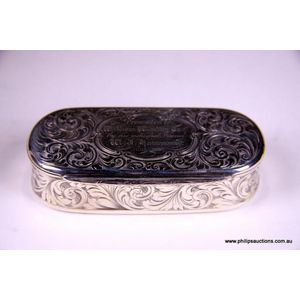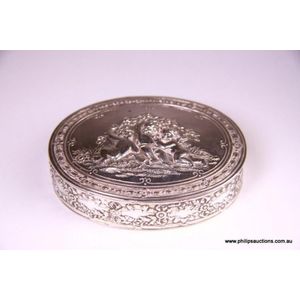Victorian Silver Putti Patchbox
You must be a subscriber, and be logged in to view price and dealer details.
Subscribe Now to view actual auction price for this item
When you subscribe, you have the option of setting the currency in which to display prices to $Au, $US, $NZ or Stg.
- Floral Swag / Garland / Festoon - Floral swags are a decorative motif often used in the ornamentation of various objects, such as silverware, glassware, and furniture. The term "swag" refers to a garland or wreath of flowers, foliage, or other decorative elements, which is usually arranged in a loop or curve.
Floral swags can be found in a variety of decorative styles, from ornate Baroque and Rococo designs to more naturalistic Art Nouveau and Art Deco styles. They are often used to add a touch of elegance, refinement, or whimsy to an object, and can be seen on a range of items from chandeliers and candlesticks to picture frames and tea sets.
In the decoration of silver objects, floral swags are often used to accentuate the curves and lines of the piece, and to add visual interest to the surface. Similarly, on glass objects, floral swags may be used to frame or highlight a particular area of the object, or to add a touch of color and delicacy.
On furniture, floral swags can be found on a variety of pieces, from cabinets and armoires to chairs and sofas. They are often used to enhance the lines and curves of the furniture, and can be used to create a sense of movement and flow in the design.
Overall, floral swags are a versatile decorative element that can be adapted to a range of styles and applications, and have been used in the decoration of various objects throughout history. - Embossed / Repousse - Embossing, also known as repousse, is the technique of decorating metal with raised designs, by pressing or beating out the design from the reverse side of the object.It is the opposite of chasing, where the decoration is applied from the front. An embossed or repoussed object may have chasing applied to finish off the design.
- Victorian Period - The Victorian period of furniture and decorative arts design covers the reign of Queen Victoria from 1837 to 1901. There was not one dominant style of furniture in the Victorian period. Designers used and modified many historical styles such as Gothic, Tudor, Elizabethan, English Rococo, Neoclassical and others, although use of some styles, such as English Rococo and Gothic tended to dominate the furniture manufacture of the period.
The Victorian period was preceded by the Regency and William IV periods, and followed by the Edwardian period, named for Edward VII (1841 ? 1910) who was King of the United Kingdom and the British Dominions and Emperor of India for the brief period from 1901 until his death in 1910. - Putto / Putti / Amorino / Amorini - A putto (plural: putti) or amerino (plural: amerini) is a cherub or cupid frequently appearing in both mythological and religious paintings and sculpture, especially of the Renaissance and Baroque periods and later used as a decorative element in the design of furniture, ceramics, statuary etc. They are usually depicted as chubby males, or of indeterminate gender, often with wings. Their depiction may represent an association with love, heaven, peace or prosperity.
- Cartouche - An ornamental panel in the form of of a shield, oval or rectangular scroll with curling edges. It may be carved into the back of a chair or the top of a sideboard, or present on a piece of silver or jewellery, and contain the initials of the original owner, heraldic symbols, or some other inscription, such as the details of a presentation.
In ceramics the term defines the central area of a vase or similar with a decorative border in one of the shapes above, into which a decorative scene or figures have been painted.
This item has been included into following indexes:
Visually similar items

Sterling silver snuff box stamped 925, weighs 24 grams

Early 18th century Delft plate, of circular form, decorated with a fence and flowers, surrounded by stylised floral border, diameter 30 cm

An oval continental silver snuff box, French 19th century, 54gms 7.5 cm long

A Victorian sterling silver patch box, 1853 Birmingham, with maker's mark for Hilliard & Thomason, the elongated rounded box with a slightly waisted body, finely engraved with acanthus scrolls throughout, the lid bearing an inscription to William Whitby Es
